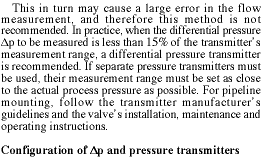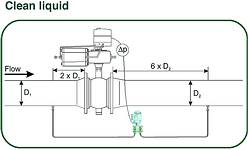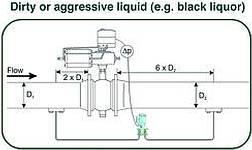
Metso’s Nelflow is a control valve doubling as a flow meter – in other words, the inherent flow characteristics and pressure drop over the valve are used in measuring flow rate through the valve installed in a pipeline. This article looks at how this instrument can be used with the different mediums found in the pulp and paper industry.
Using a differential pressure transmitter
The primary method to measure pressure drop over a valve is to use a differential pressure transmitter. This gives the most accurate and reliable data of the pressure drop value.
An important factor with regard to accuracy is, how close to the actual conditions the measurement range of the transmitter is set. For pipeline mounting, follow the transmitter manufacturer's guidelines and the Nelflow 8 NDQ 70 installation, maintenance and operating instructions.
Using separate pressure transmitters
Another method for pressure drop measurement is to use two separate pressure transmitters, located upstream and downstream of the valve in a pipeline. The differential pressure is then calculated by means of subtraction.
However, depending on the accuracy of the individual pressure transmitters and on the magnitude of the pressure drop as compared to the static pressure measurement range, this method can lead to significant error in differential pressure.

The configuration of the transmitters to the Nelflow is made with the Valve Manager software, using the Hart protocol for communication. In the Nelflow valve controller, input 1 is for upstream pressure and input 2 for either differential or downstream pressure (selection in the software). If pressure is not measured, it must be set to a constant value - eg if only a differential pressure transmitter is used and connected to input 2 then a constant value of upstream pressure must be set to input 1.
Pressure measurement points
The recommended distances between the pressure measurements and valve are as follows: the upstream pressure measurement should be located at a distance of two times pipe diameter before the valve, the downstream measurement at a distance of six times pipe diameter.
This is necessary because the Cv-curve of the valve is measured according to international standards using these distances, this allows known Cv-curves to be used. If the recommended distances cannot be used for some reason, the effect of deviating distance on the Cv-curve can be taken into account with the Valve Manager software, following these guidelines:
* Be sure that there is no additional pressure loss (apart from normal pipe friction) between the valve and the pressure measurement point - eg no shut-off valves etc.
* With butterfly valves, the distance of the downstream pressure measurement must not be shorter than six times pipe diameter.
* With other type of valves, the distance between valve and downstream pressure measurement must be at least four times pipe diameter.
* Be sure that pressure is measured from the flow controlled by the valve - for example, do not locate the downstream pressure measurement in a T-joint where the total flow is the sum of two combined flows.
The most common accessories
* Impulse tube (pressure pipe) - a tube from process pipeline to the differential pressure transmitter, filled with process medium which is thus in direct contact with the transmitter .
* Condensate trap (condensate pot) - small vessel mounted to the side of pipeline from which the output of the impulse tube is taken. Condensate traps are used when the medium is steam, filling the trap and the impulse tube with water so that the high temperature of the steam cannot affect the transmitter.
* Hydraulic pressure seal - device that transmits the pressure to be measured from the process fluid to the transmitter. Its main components are the top and bottom sections of the seal, a separating diaphragm and a capillary tube with filling fluid. Hydraulic pressure seals are used whenever there must be no contact between the measuring instruments and the process fluid. Typically, they are applied when the medium is hot, corrosive, highly viscous, or may block the impulse tube.
Application-based recommendations
Usually the pressure drop is measured with a differential pressure transmitter, but in certain conditions the accurate information of the upstream pressure p1 is also needed. For the most typical applications, the following is recommended:
Clean liquid
In most applications, information of the pressure drop is enough and it can be measured using a differential pressure transmitter. If the flow in a valve is cavitating and choking occurs, information of upstream pressure is needed for correct flow calculation. Mount the differential pressure transmitter below the tapping point, so that the impulse tube is always filled with liquid and gas bubbles can run back into the process pipe.
Steam
The measurement of steam flow is based on the pressure drop over the valve and the upstream steam density, calculated from the actual steam pressure and temperature at the valve inlet. Use a differential pressure transmitter to measure the pressure drop, and pressure and temperature transmitters to measure the actual values at the valve inlet. The upstream pressure transmitter is connected to input 1 and the temperature transmitter to input 3 in Nelflow valve controller. If pressure and temperature variations are negligible, a constant value can be set by the Valve Manager. For example in the temperature range 100 to 280°C a variation of 10° gives an error of 1,5 to 1,0% in the flow. Mount the differential pressure transmitter below the tapping point. Condensate traps are always used in the impulse tube, mounted at the same level as the tapping points. Fill traps with water before calibration.
Gases
The measurement of gas flow is based on the pressure drop over the valve and the upstream gas density, calculated from the actual gas pressure and temperature at the valve inlet. Use a differential pressure transmitter to measure the pressure drop, and pressure and temperature transmitters to measure the actual values at the valve inlet.
If pressure and temperature variations are negligible, a constant value can be set by the Valve Manager. For example in the temperature range 0 to 200°C a variation of 10° gives an error of 1,8 to 1,0% in the flow. Mount the differential pressure transmitter above the tapping point, so that condensate runs back into the process piping.
Pulp stock
Flow rate through the valve is based on the pressure drop over the valve and the actual pulp consistency. Pressure drop can be measured with a differential pressure transmitter.
Because pulp can easily block the impulse tube from the tap to the transmitter, hydraulic pressure seals are used to transmit the pressure from the pulp flow to the transmitter. If separate pressure transmitters are used, choose transmitters of flush diaphragm type. The actual pulp consistency can be measured by a consistency transmitter or set as a constant value by the Valve Manager.
Input 4 in the Nelflow valve controller is for the consistency transmitter connection. The effect of consistency on flow rate depends on the actual consistency and on the pressure drop. For example, if consistency changes from 2 to 4%, its effect on flow rate is 2 to10% depending on the pressure drop - as can be seen from the correction coefficient k for mechanical pulp stock in the graph. If the consistency does not vary much, a constant value can be set by the Valve Manager, which includes correction for mechanical, kraft and recycled pulp stock.

Dirty or aggressive liquid (eg black liquor)
Pressure drop must be measured using a differential pressure transmitter with hydraulic pressure seals. The separating diaphragm must be made of special materials and with special coating to endure the effects of high concentration, temperature, and other factors causing extreme wear. Separate pressure transmitters cannot be used.

Erosive medium (eg lime kiln)
Measurements from erosive medium must be considered case-by-case, and no general recommendations are given. Differential pressure transmitter hydraulic pressure seals can be used, provided that suitable separating diaphragm material is available. A pressure transmitter with ceramic diaphragm (Endress+Hauser Cerabar M PMC 45) is available.
Pressures below atmospheric pressure differential pressure transmitters can be used to measure pressure drop. If pressure transmitters are used, they normally apply to the range 40 to 100 kPa (400 to 1000 mbarA). Below 40 kPa (400 mbarA) an absolute pressure transmitter has to be used - however, temperature also plays a role here, and therefore the measurement has to be considered case by case.
Metso Automation
(031) 502 9350

© Technews Publishing (Pty) Ltd | All Rights Reserved